#bbc three counties
Explore tagged Tumblr posts
Text
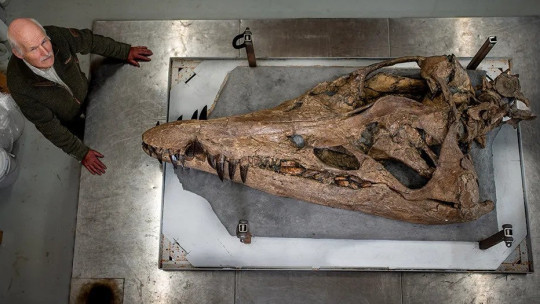
Gigantic Skull of Prehistoric Sea Monster Found on England’s ‘Jurassic Coast’
The remarkably well-preserved skull of a gigantic pliosaur, a prehistoric sea monster, has been discovered on a beach in the county of Dorset in southern England, and it could reveal secrets about these awe-inspiring creatures.
Pliosaurs dominated the oceans at a time when dinosaurs roamed the land. The unearthed fossil is about 150 million years old, almost 3 million years younger than any other pliosaur find. Researchers are analyzing the specimen to determine whether it could even be a species new to science.
Originally spotted in spring 2022, the fossil, along with its complicated excavation and ongoing scientific investigation, are now detailed in the upcoming BBC documentary “Attenborough and the Jurassic Sea Monster,” presented by legendary naturalist Sir David Attenborough, that will air February 14 on PBS.

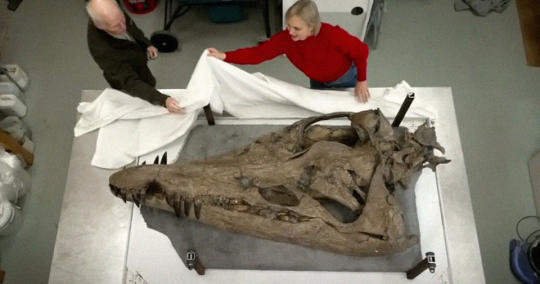
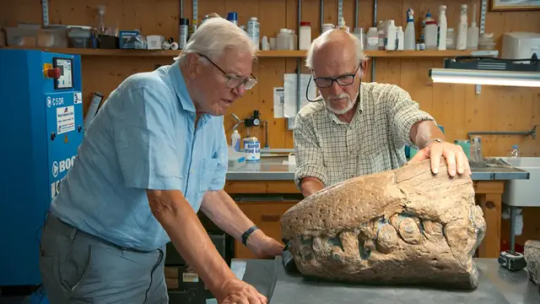
Such was the enormous size of the carnivorous marine reptile that the skull, excavated from a cliff along Dorset’s “Jurassic Coast,” is almost 2 meters (6.6 feet) long. In its fossilized form, the specimen weighs over half a metric ton. Pliosaurs species could grow to 15 meters (50 feet) in length, according to Encyclopaedia Britannica.
The fossil was buried deep in the cliff, about 11 meters (36 feet) above the ground and 15 meters (49 feet) down the cliff, local paleontologist Steve Etches, who helped uncover it, said in a video call.
Extracting it proved a perilous task, one fraught with danger as a crew raced against the clock during a window of good weather before summer storms closed in and the cliff eroded, possibly taking the rare and significant fossil with it.
Etches first learned of the fossil’s existence when his friend Philip Jacobs called him after coming across the pliosaur’s snout on the beach. Right from the start, they were “quite excited, because its jaws closed together which indicates (the fossil) is complete,” Etches said.

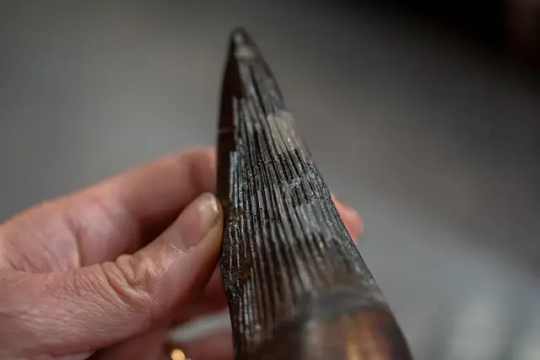
After using drones to map the cliff and identify the rest of the pliosaur’s precise position, Etches and his team embarked on a three-week operation, chiseling into the cliff while suspended in midair.
“It’s a miracle we got it out,” he said, “because we had one last day to get this thing out, which we did at 9:30 p.m.”
Etches took on the task of painstakingly restoring the skull. There was a time he found “very disillusioning” as the mud, and bone, had cracked, but “over the following days and weeks, it was a case of …, like a jigsaw, putting it all back. It took a long time but every bit of bone we got back in.”
It’s a “freak of nature” that this fossil remains in such good condition, Etches added. “It died in the right environment, there was a lot of sedimentation … so when it died and went down to the seafloor, it got buried quite quickly.”
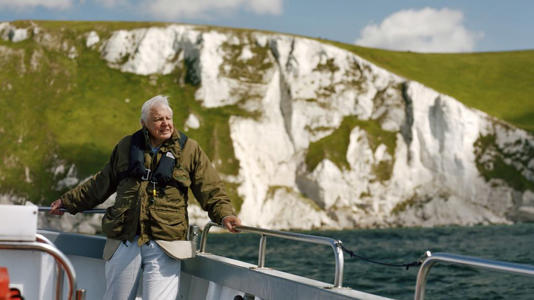

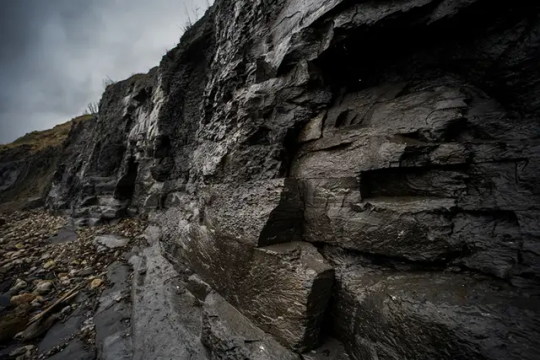
Fearsome top predator of the seas
The nearly intact fossil illuminates the characteristics that made the pliosaur a truly fearsome predator, hunting prey such as the dolphinlike ichthyosaur. The apex predator with huge razor-sharp teeth used a variety of senses, including sensory pits still visible on its skull that may have allowed it to detect changes in water pressure, according to the documentary.
The pliosaur had a bite twice as powerful as a saltwater crocodile, which has the world’s most powerful jaws today, according to Emily Rayfield, a professor of paleobiology at the University of Bristol in the United Kingdom who appeared in the documentary. The prehistoric marine predator would have been able to cut into a car, she said.
Andre Rowe, a postdoctoral research associate of paleobiology at the University of Bristol, added that “the animal would have been so massive that I think it would have been able to prey effectively on anything that was unfortunate enough to be in its space.”
By Issy Ronald.


#Gigantic Skull of Prehistoric Sea Monster Found on England’s ‘Jurassic Coast’#Dorset England#pliosaur#jurassic#fossil#prehistoric#dinosaur#paleobiology#palaeontologists#archaeology#archeolgst#history#history news#ancient history#Sir David Attenborough#nature#naturalist
622 notes
·
View notes
Text

Margaret Hilda Thatcher, Baroness Thatcher
LG, OM, DStJ, PC, FRS, HonFRSC (née Roberts; 13 October 1925 – 8 April 2013) was a British stateswoman and Conservative politician who was Prime Minister of the United Kingdom from 1979 to 1990 and Leader of the Conservative Party from 1975 to 1990. She was the longest-serving British prime minister of the 20th century and the first woman to hold the position. As prime minister, she implemented economic policies known as Thatcherism. A Soviet journalist dubbed her the "Iron Lady", a nickname that became associated with her uncompromising politics and leadership style.
Thatcher studied chemistry at Somerville College, Oxford, and worked briefly as a research chemist before becoming a barrister. She was elected Member of Parliament for Finchley in 1959. Edward Heath appointed her secretary of state for education and science in his 1970–1974 government. In 1975, she defeated Heath in the Conservative Party leadership election to become leader of the opposition, the first woman to lead a major political party in the UK.
On becoming prime minister after winning the 1979 general election, Thatcher introduced a series of economic policies intended to reverse high inflation and Britain's struggles in the wake of the Winter of Discontent and an oncoming recession. Her political philosophy and economic policies emphasised greater individual liberty, the privatisation of state-owned companies, and reducing the power and influence of trade unions. Her popularity in her first years in office waned amid recession and rising unemployment. Victory in the 1982 Falklands War and the recovering economy brought a resurgence of support, resulting in her landslide re-election in 1983. She survived an assassination attempt by the Provisional IRA in the 1984 Brighton hotel bombing and achieved a political victory against the National Union of Mineworkers in the 1984–85 miners' strike. In 1986, Thatcher oversaw the deregulation of UK financial markets, leading to an economic boom, in what came to be known as the Big Bang.
Thatcher was re-elected for a third term with another landslide in 1987, but her subsequent support for the Community Charge (also known as the "poll tax") was widely unpopular, and her increasingly Eurosceptic views on the European Community were not shared by others in her cabinet. She resigned as prime minister and party leader in 1990, after a challenge was launched to her leadership, and was succeeded by John Major, her chancellor of the Exchequer. After retiring from the Commons in 1992, she was given a life peerage as Baroness Thatcher (of Kesteven in the County of Lincolnshire) which entitled her to sit in the House of Lords. In 2013, she died of a stroke at the Ritz Hotel, London, at the age of 87.
A polarising figure in British politics, Thatcher is nonetheless viewed favourably in historical rankings and public opinion of British prime ministers. Her tenure constituted a realignment towards neoliberal policies in Britain; the complex legacy attributed to this shift continues to be debated into the 21st century.
Reputation
Thatcher's tenure of 11 years and 209 days as British prime minister was the longest since Lord Salisbury in the late 19th century (13 years and 252 days, in three spells) and the longest continuous period in office since Lord Liverpool in the early 19th century (14 years and 305 days).
Having led the Conservative Party to victory in three consecutive general elections, twice in a landslide, she ranks among the most popular party leaders in British history regarding votes cast for the winning party; over 40 million ballots were cast in total for the party under her leadership. Her electoral successes were dubbed a "historic hat trick" by the British press in 1987.
Thatcher ranked highest among living persons in the 2002 BBC poll 100 Greatest Britons. In 1999, Time deemed Thatcher one of the 100 most important people of the 20th century. In 2015 she topped a poll by Scottish Widows, a major financial services company, as the most influential woman of the past 200 years; and in 2016 topped BBC Radio 4's Woman's Hour Power List of women judged to have had the biggest impact on female lives over the past 70 years. In 2020, Time magazine included Thatcher's name on its list of 100 Women of the Year. She was chosen as the Woman of the Year in 1982 when the Falklands War began under her command, resulting in the British victory.
In contrast to her relatively poor average approval rating as prime minister, Thatcher has since ranked highly in retrospective opinion polling and, according to YouGov, is "see[n] in overall positive terms" by the British public. Just after her death in 2013, according to a poll by The Guardian, about half of the public viewed her positively while one third viewed her negatively. In a 2019 opinion poll by YouGov, most Britons rated her as Britain's greatest post-war leader (with Churchill coming second). According to the poll, more than four in ten Britons (44%) think that Thatcher was a "good" or "great" prime minister, compared to 29% who think she was a "poor" or "terrible" one. She was voted the fourth-greatest British prime minister of the 20th century in a 2011 poll of 139 academics organised by MORI. In a 2016 University of Leeds survey of 82 academics specialising in post-1945 British history and politics, she was voted the second-greatest British prime minister after the Second World War.
Daily inspiration. Discover more photos at Just for Books…?
11 notes
·
View notes
Text



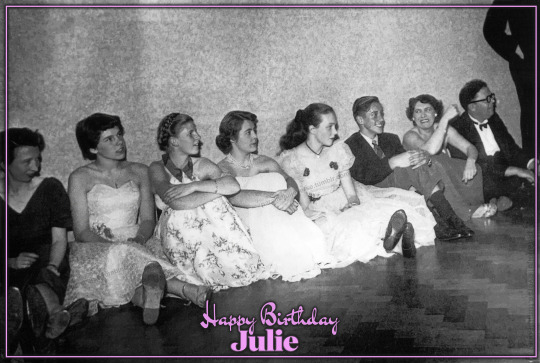

A Milestone in Time: Julie Andrews' 15th Birthday Celebration
In honour of Julie Andrews' birthday on October 1, the Parallel Julieverse takes a nostalgic look back at a festive occasion from her past: her 15th birthday celebration in 1950, featuring a few photos from the party held at The Old Meuse, her childhood home in Walton-on-Thames.
A 15th birthday is a significant coming-of-age milestone in many cultures, marking the transition from childhood to adolescence and the onset of adult responsibilities. For Julie, it was particularly meaningful, as it marked her release from UK juvenile labour laws, allowing her to work freely as an adult. In her memoir, she recounts:
"On October 1, I turned fifteen and was officially freed from the London County Council’s child performer restrictions…To celebrate my ‘liberation,’ Mum threw one of her great parties. There must have been about sixty people in the house. Everybody danced and jitterbugged and had a fine old time" (Andrews, 2008, pp. 128).
Elsewhere in her memoir, Julie describes how her parents' parties were legendary, with friends eagerly anticipating each gathering at The Old Meuse. The evenings typically began with drinks at the bar before moving into the sitting room, where Barbara played the piano and Ted sang, bringing the party to life. Guests danced, sang, and socialised, with Aunty Joan encouraging everyone to join the fun. Between these lively moments, there were quieter intervals for food and tea, before the revelry resumed (Andrews, 2008, pp. 89-90).
One of these "quieter" moments at Julie’s 15th birthday took a sudden, chaotic turn when an intoxicated Ted Andrews made an inappropriate remark. Annoyed by his behaviour, a family friend picked up a large dish of blancmange from the supper table and hurled it at him. As Julie recalls, "Pop ducked in the nick of time, and it hit the wall behind him…There was utter silence in the room as everyone watched the wobbly pink goop slide slowly down the wall…Then everyone began talking at once" (Andrews, 2008, pp. 129). After the mess was cleaned up, the party continued late into the night.
Interestingly, the blancmange story resurfaced three years later in a 1953 news article where it was adapted as a Christmas "anecdote from the stars." In this version, however, Julie was the one throwing the pudding, and the target was a fellow child rather than her stepfather. She writes:
“When I was seven, I had a Christmas children’s party soon after our house had been redecorated. During tea, one of the children annoyed me, so I scooped up a handful of blancmange and threw it at my guest. Of course, it missed and hit the newly-painted wall. Mummy has kept the mark as a souvenir to this day” (cited in Hubbard, 1953, p. 5)
This was likely a bit of PR embellishment, but if it really was another flying blancmange incident, the walls of The Old Meuse must have been a frightful mess!
Either way, Julie's birthday respite was short-lived. By Monday morning, she was back at the BBC's Paris Cinema for rehearsals ahead of that evening’s broadcast of Educating Archie. Two days later, she was on a train to Manchester for a charity concert, before returning to London for another week of shows. Such was the gruelling schedule that young Julie Andrews maintained during these early years.
Happy birthday, Dame Julie! However she chooses to celebrate her 89th year, we hope the festivities are as joyful as ever—and that, this time, the blancmange stays safely on the plate!
Sources:
Andrews, J. (2008). Home: A memoir of my early years. London: Weidenfeld and Nicolson.
Hubbard, D. (1953). '"'Anecdotes of the "Stars": When Julie threw the blancmange.” Bristol Evening Post. 24 December: p. 5.
12 notes
·
View notes
Text
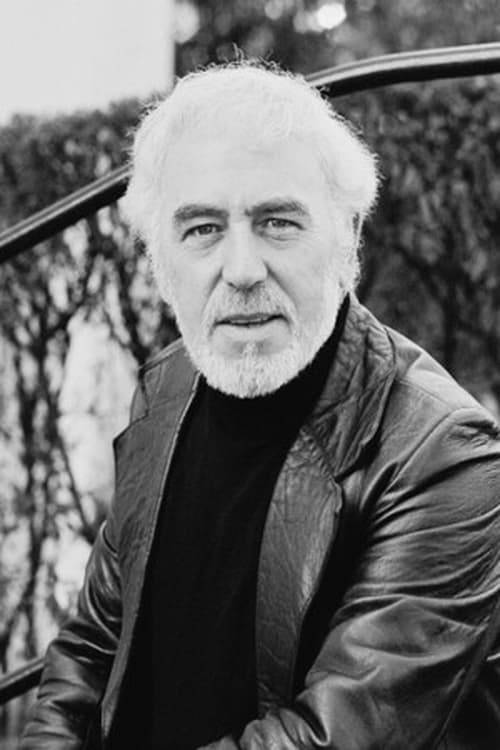
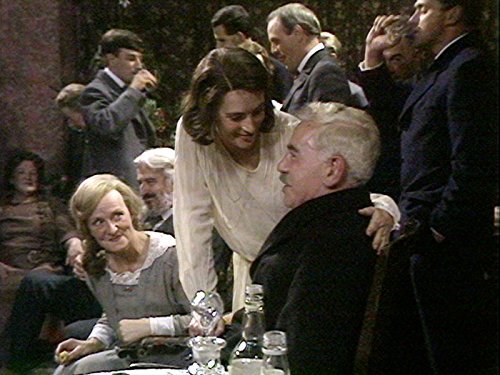
This is another in our occasional series featuring luminaries of stage and screen with a strong personal and/or professional connection with Northeast England, inspired with thanks by @robbielewis. The most recent previous instalment was on brother and sister acting duo Malcolm and Catherine Terris. This time, James Garbutt.
As with some of our previous subjects, there is an unsatisfying lack of biographical information available; James Garbutt seems to have built a solid career over decades without a high public or media profile.
He was born in Houghton-le-Spring, County Durham, in 1925. In World War Two he was an RAF pilot serving in Africa, subsequently worked as an art teacher and became a leading member of the socialist theatre company, Newcastle People’s Theatre, throughout the 1950s and 60s.
He was active in British television between 1969 and 2002, with his breakthrough role in the 1970s BBC blockbuster, The Onedin Line, replacing Brian Rawlinson for season three (only) as Robert Onedin. (It appears that Rawlinson did not want to continue in the role, but for whatever reason returned for season four and remained until they eventually killed off the character).
James Garbutt is perhaps best remembered for his intense performance as Bill Seaton, the prickly patriarch of the Seaton family and veteran pitman who is paralysed in an underground accident, in 39 episodes of the Tyneside social realism drama, When the Boat Comes In (1976-77).
Amongst over 60 recorded screen credits, his other television appearances include three episodes of Doctor Who (Genesis of the Daleks, 1975), Z Cars, Whatever Happened to the Likely Lads, Middlemarch, The Bill, the political drama Bill Brand, and three separate characters over eight episodes of Coronation Street between 1970 and 1997. He also appeared in the Superman: The Movie (1978), starring Christopher Reeve.

About to bite the dust courtesy of the Daleks in Doctor Who
In addition to his work for the Newcastle People’s Theatre, his stage appearances include several productions for the Royal Shakespeare Company, including the stage version of Our Friends in the North which preceded the hit televisions series, for the Leeds Theatre Trust, Alexandra Theatre (Birmingham) and Tyneside Theatre Company.
He passed away in 2020, aged 94.
#social history#uk politics#working class history#social justice#british culture#british actors#british theatre#british television#northeast england#geordie#county durham#doctor who#coronation street#when the boat comes in#the onedin line
16 notes
·
View notes
Text
"The probable Liberal candidate for Mid-Devon at the next election"
I thought it might be worth discussing this line in more depth, with some further points about elections in late Victorian Britain, with some reference to the recent one.
Funnily, you can actually got through this largely word by word.
The
While many of them had been abolished, there were still a number of seats that elected two MPs, such as Bath and Devonport.
You still had some "university constituences" where Masters and Doctorate level graduates could vote for two MPs. These would persist until the 1950 General Election.
The UK has pretty much always used the plurality system for General Elections aka "first past the post". Highest number of votes wins. This can result in someone getting in with 34% of the vote, which happened at the 2024 election.
In the case of a two-member seat, the top two candidates got elected. This multi-member practice is still standard for local council elections.
Probable
The UK election period is pretty short. The last election had Rishi Sunak ask the King for a dissolution on 22 May, Parliament dissolved on the 30th and the deadline for nominations on 4 June, a month before the actual election on 4 July.
The Victorians had the actual voting spread over 24 days in the 1892 election; it was possible for a candidate to lose one election, quickly get nominated in another seat and win that one.
Candidates would not therefore be fully confirmed under the formal nomination by their local party, although today the national party has a good deal of control over the process:
However, it is today common place to have "prospective parliamentary candidates" in place before an election is called. This allows them to campaign without becoming formal candidates and being subject to our strict electoral spending rules.
The UK also has its own equivalent of "carpetbaggers", known as "parachute candidates". Party HQ will "parachute" someone they want into a safe or winnable seat, frequently to the at least mild displeasure of the local party. Notable parachutists include George Galloway, Boris Johnson, Margaret Thatcher and Roy Jenkins.
Liberal
The UK had three major parties in 1889:
The Conservative and Unionist Party, generally shortened to the Conservatives or the Tories. Led by the Marquess of Salisbury, the incumbent PM since the election of 1886 gave him an overall majority. The latter is an insulting term derived from an Irish word for "outlaw", but today can be used in a neutral way - the BBC's Style Guide allows it to be used for later references. The Conservatives do not use it themselves formally. The Unionist part referred to their support for the union between Great Britain and Ireland; they had significant support in the (more Protestant) Ulster province of the latter, six of the nine counties of which would become Northern Ireland. As such they opposed "Home Rule" i.e. Irish self-determination in domestic affairs with their own parliament, although Salisbury's government did implement various reforms in Ireland seeking to "kill Home Rule by kindness". They generally favoured protectionism and a policy of keeping Britain out of foreign alliances.
The Liberals: Led by William Gladstone, considered one of our greatest Prime Ministers. Known as the G.O.M. (Grand Old Man or God's Only Mistake, depending on your POV), he had been Prime Minister for the third time during a short-lived 1886 ministry started and ended over Home Rule - he'd forced out Salisbury by a defeat over the matter with Irish support, then had his legislation defeated in the Commons, forcing an election. The Liberals had split over Home Rule, a Liberal Unionist wing aligning with the Conservatives and eventually merging with them. The Liberals favoured increased worker rights and expanding the franchise.
Irish Parliamentary Party: Made up of Irish nationalists (commonly, but not always Catholic) who wanted autonomy and land reform, they were led by Charles Stewart Parnell. Opposed to militancy in the name of Home Rule or even full independence, which was getting quite common at this time. Parnell would foil an attempt to smear him as pro-violence by forged letters claiming he was complicit in a double assassination in Phoenix Park in 1882; he requested an official enquiry and the journalist, Richard Piggott, broke down under cross-examination. Piggott was then sued for libel by Parnell, lost, then fled to Madrid where he shot himself. However, the following year, Parnell was revealed via a divorce trial to have had a long affair with a married woman called Katharine ("Katie" to her friends, "Kitty" to her enemies, the latter being a slang term for prostitute) O'Shea, fathering three of her children and "living in sin" with her. The scandal was huge, with the Catholic Church coming out against him. Refusing to resign, the party split, with the majority becoming the anti-Parnell Irish National League. Parnell married Katherine in 1891, but his health was failing due to stomach cancer and heart disease - he would die in her arms four months later. His minority faction collapsed shortly after.
While trade unions were a growing political force, the Labour Party had yet to really come into being.
Candidate
In 1892, there were 6.16 million registered voters, therefore eligible to run for the House of Common. As is obvious, universal suffrage was not a thing at this point.
This page covers the qualifications to vote and ergo, I believe, run in 1900:
For further explanation:
Of full age means over 21. The UK lowered the age to 18 in 1969, two years before the US did.
Receipt of what we would today call benefits, bar medical ones, meant no vote. Insert your own joke here.
Conviction for corrupt electoral practices also cost you your right to vote. Being incarcerated after a conviction (but not if you are on remand) today also bars you from voting, but this does not carry over after your release.
Alienage means being a foreigner, not being an extraterrestrial.
Looking at this, I believe that both Watson and Holmes would have been eligible voters. Certainly later in their careers.
Peers were and still aren't eligible to vote or run for the House of Commons. Baronets are hereditary knights and therefore not peers.
You could run as an independent candidate, but these winning were pretty rare. Having just two candidates on the ballot paper was not uncommon either.
The secret ballot having been introduced in 1872, voters would now going into a booth or partitioned area and mark their choice with a 'X', the traditional signature of the illiterate. We have never used voting machines here. It would then be dropped into a padlocked metal box.
The ballots would contain the name of the candidate and their residence. It would not have their party affiliation on it. Candidates would have to explain via posters and leaflets who supporters should vote for:
A candidate could not pull out after nominations closed - if they died and weren't an independent, the election would have to be re-run. In 2024, a number of candidates lost their party endorsement due to various controversies at the point it was too late to take them off the papers.
Mid-Devon
Our parliamentary consituencies have names, unlike the numerical districts used for the US House of Representatives.
Redistricting or boundary changes were and are done by independent boundary commissions. The Redistribution of Seats Act 1885 created three commissions (England & Wales, Scotland and Ireland) with the new requirement to keep elector populations broadly equal in each seat. Seats were expected to be compact and follow local boundaries where reasonably practical; none of those silly American district shapes here, thank you.
No further boundary changes would be done until 1918.
Mid-Devon is fictituous - I have not been able to find the name of the relevant RL consituency for the area.
Next Election
Barring the period between 2011 and 2022 where elections were fixed or required the Commons to authorise them by a 2/3 vote, the date of the next election is in the gift of the Prime Minister, who must call it within five years of the last election. In 1889, it was seven years.
The PM can ask for a dissolution and new election from the monarch at any time in that period, which is nearly always granted unless there is a viable alternative government available.
PMs generally try to call an election at the best time for them politically; sometimes it's expected, other times it will wrong foot people. The 2024 election being held in 4 July surprised nearly everyone, including many in Sunak's own party.
Salisbury called the election for 4 to 26 July 1892. The results saw the Conservative/Liberal Unionist alliance lose its overall majority, but Salisbury hung on until 12 August when the Liberals and INL collectively defeated the government in a vote of no confidence. Salisbury resigned and advised Queen Victoria to send for Gladstone. The latter, now 82, formed a minority government reliant on Irish Nationalist votes and made another attempt at Home Rule in 1893, blocked by the Lords.
Gladstone would resign the following year on health grounds and Victoria then selected Lord Rosebery to succeed him, basically as he was the only Liberal she liked.
Further notes
The House of Lords and the House of Commons were equal in power at this point; the former could therefore veto bills and block the budget.
Results were and still are announced in public declarations, these days televised. The candidates going up on the stage are privately told by the Returning Officer the results, then told not to show any sign of what has happened as they go up. It's very much poker face time.
Postal ballots are a thing, but they must be returned by close of poll on election day.
The former practice of "chairing", basically a victory parade involving the new elected member sitting on a chair and being carried around the town, had stopped in 1880.
The Oaths Act of 1888 eliminated the requirement of members to swear an oath of allegiance to the monarch, allowing them to affirm instead. This allowed non-Christians to take their seats, as well as those Christians who do not agree with swearing oaths. It is now possible to use any religious text you like when doing the oath or affirmation. However, the allegiance to the monarch bit remains to this day - Sinn Fein, who wish to see Northern Ireland become part of Ireland, refuse to take their seats because of this, while a number of MPs did this bit under protest because of their opposition to the monarchy.
12 notes
·
View notes
Text
Doctor Who convention raises thousands for charity

Paul McGann said he enjoyed meeting fans at the event and one gave him a certificate naming a planet after him
Doctor Who actor Paul McGann has praised a convention he took part in after it raised over £17,000 for charity.
The ninth annual Bedford Who event was held on Saturday, where fans paid for autographs and selfies with stars of the BBC television show.
Money raised has been split between Bedford Foodbank, homeless charity Smart, and FACES, which supports vulnerable families.
McGann, who starred in the 1996 Doctor Who TV movie, said the event had a more friendly feel to bigger, "pretty commercial" conventions he had done in America.

Some fans attended the event at King's House in Bedford dressed as characters from the show
He said fans gave him gifts on the day including sweets, artwork and even a naming certificate for a planet.
"It's been lovely, it's been friendly, we can literally look each other in the eye, I prefer that," he said.
The actor, 64, told BBC Three Counties Radio he considered visiting nearby Stony Stratford, where he filmed part of the 1987 film Withnail & I.
A chemist in the town was transformed into a tea room for the black comedy, where McGann and Richard E Grant's characters drunkenly demanded cake and fine wine.
He said: "It was a big deal because Withnail was filmed all in London or the Lakes except just for that little bit of Milton Keynes.
"Do you think if I go back to the place will anybody twig that it's me?"

Organiser Simon Danes said the money raised far exceeded expectations
Organiser Simon Danes said he was "gobsmacked" with the final amount raised and praised "the generosity of Doctor Who fans and kindness of celebrity guests".
The 58-year-old said: "We were expecting about 10k but we weren't expecting it to be as high as that.
Also appearing at the event was Jemma Redgrave, who recently starred on screen alongside David Tennant and new Doctor Ncuti Gatwa.
The organiser added: "Jemma is so busy she doesn't do many conventions, so we honoured she has come to us.
"It's the first time we had a star of the current series with us."
The retired teacher added: "Next year is our 10th anniversary, so we're hoping to do something even more special, don't ask me what is yet."
13 notes
·
View notes
Text
ive not been in my home city for about a week now, and all i can see on the news is far right groups rioting there (using missiles and everything)- it makes me quite sad how people can use the death of three small children to spread such hate around the place i like to call homev
and it does seem like the coutnry is changing aswell- today a group of friends and I were supposed to go outdoor swimming in a town nearby where were staying (in the middle of nowhere) but we weren't allowed as yesterday there was another riot (again far right group and involving missiles) of 400 people.
it's really sad to me seeing the news again and again and it's just 'hundreds of people gathered in (place in my own county) attacking members of the public' over what- misinformation about the killer of 3 children in Southport
looking on BBC news and a lot of these places also happen to be towns in the north of England, a place I am very proud to come from, a place where people used to protest for womens rights, workers rights, not the far right.
and it's just really sad that instead of mourning Elise, Alice and Bebe, and wishing the best for the other children in hospital, people have to hurt more people, and push the blame onto Muslims and immigrants, when really our whole country is made up of immigrants if you go back far enough
#gi's rambles#this isnt really supposed to say anything or make any sense its just a vent#i love home but i dont really know if i want to go back if its like this#especially since this would put me in direct danger if these are still happening in september#vent#please ignore this if you want to#uk politics#southport
6 notes
·
View notes
Text
The Ghostly Radio Station That No One Claims to Run
Zaria Gorvett

In the middle of a Russian swampland, not far from the city of St Petersburg, is a rectangular iron gate. Beyond its rusted bars is a collection of radio towers, abandoned buildings and power lines bordered by a dry-stone wall. This sinister location is the focus of a mystery which stretches back to the height of the Cold War.
It is thought to be the headquarters of a radio station, “MDZhB”, that no-one has ever claimed to run. Twenty-four hours a day, seven days a week, for the last three-and-a-half decades, it’s been broadcasting a dull, monotonous tone. Every few seconds it’s joined by a second sound, like some ghostly ship sounding its foghorn. Then the drone continues.
Once or twice a week, a man or woman will read out some words in Russian, such as “dinghy” or “farming specialist”. And that’s it. Anyone, anywhere in the world can listen in, simply by tuning a radio to the frequency 4625 kHz.
It’s so enigmatic, it’s as if it was designed with conspiracy theorists in mind. Today the station has an online following numbering in the tens of thousands, who know it affectionately as “the Buzzer”. It joins two similar mystery stations, “the Pip” and the “Squeaky Wheel”. As their fans readily admit themselves, they have absolutely no idea what they are listening to.

Anyone can listen to the Buzzer, simply by tuning a radio to the frequency 4625 kHz (Credit: iStock)
In fact, no-one does. “There’s absolutely no information in the signal,” says David Stupples, an expert in signals intelligence from City University, London.
What’s going on?
The frequency is thought to belong to the Russian military, though they’ve never actually admitted this. It first began broadcasting at the close of the Cold War, when communism was in decline. Today it’s transmitted from two locations – the St Petersburg site and a location near Moscow. Bizarrely, after the collapse of the Soviet Union, rather than shutting down, the station’s activity sharply increased.
There’s no shortage of theories to explain what the Buzzer might be for – ranging from keeping in touch with submarines to communing with aliens. One such idea is that it’s acting as a “Dead Hand” signal; in the event Russia is hit by a nuclear attack, the drone will stop and automatically trigger a retaliation. No questions asked, just total nuclear obliteration on both sides.
This may not be as wacky as it sounds. The system was originally pioneered in the Soviet era, where it took the form of a computer system which scanned the airwaves for signs of life or nuclear fallout. Alarmingly, many experts believe it may still be in use. As Russian president Vladimir Putin pointed out himself earlier this year, “nobody would survive” a nuclear war between Russia and the United States. Could the Buzzer be warding one off?
As it happens, there are clues in the signal itself. Like all international radio, the Buzzer operates at a relatively low frequency known as “shortwave”. This means that – compared to local radio, mobile phone and television signals – fewer waves pass through a single point every second. It also means they can travel a lot further.
While you’d be hard pressed to listen to a local station such as BBC Radio London in a neighbouring county, shortwave stations like the BBC World Service are aimed at audiences from Senegal to Singapore. Both stations are broadcast from the same building.

If the “dead hand” system did not detect signs of a preserved military hierarchy it would automatically trigger a retaliation (Credit: Public Domain/ US DoD)
It’s all thanks to “skywaves”. Higher frequency radio signals can only travel in a straight line, eventually becoming lost as they bump into obstacles or reach the horizon. But shortwave frequencies have an extra trick – they can bounce off charged particles in the upper atmosphere, allowing them to zig-zag between the earth and the sky and travel thousands, rather than tens, of miles.
Which brings us back to the Dead Hand theory. As you might expect, shortwave signals have proved extremely popular. Today they’re used by ships, aircraft and the military to send messages across continents, oceans and mountain ranges. But there’s a catch.
The lofty layer isn’t so much a flat mirror, but a wave, which undulates like the surface of the ocean. During the day it moves steadily higher, while at night, it creeps down towards the Earth. If you want to absolutely guarantee that your station can be heard on the other side of the planet – and if you’re using it as a cue for nuclear war, you probably do – it’s important to change the frequency depending on the time of day, to catch up. The BBC World Service already does this. The Buzzer doesn’t.
Another idea is that the radio station exists to “sound” out how far away the layer of charged particles is. “To get good results from the radar systems the Russians use to spot missiles, you need to know this,” says Stupples. The longer the signal takes to get up into the sky and down again, the higher it must be.
Alas, that can’t be it either. To analyse the layer’s altitude the signal would usually have a certain sound, like a car alarm going off – the result of varying the waves to get them just right. “They sound nothing like the Buzzer,” says Stupples.
Intriguingly, there is a station with some striking similarities. The “Lincolnshire Poacher” ran from the mid-1970s to 2008. Just like the Buzzer, it could be heard on the other side of the planet. Just like the Buzzer, it emanated from an undisclosed location, thought to be somewhere in Cyprus. And just like the Buzzer, its transmissions were just plain creepy.
At the beginning of every hour, the station would play the first two bars of an English folk tune, the Lincolnshire Poacher.
“Oh ‘tis my delight on a shining night
In the season of the year
When I was bound apprentice in famous Lincolnshire
‘Twas well I served my master for nigh on seven years…”
After repeating this 12 times, it would move on to messages read by the disembodied voice of a woman reading groups of five numbers – “1-2-0-3-6” – in a clipped, upper-class English accent.

After the Arcos raid in London, the Russians realised they needed a better way to communicate with spies hiding abroad (Credit: Getty)
In May 1927, years after a British secret agent caught an employee sneaking into a communist news office in London, police officers stormed the Arcos building. The basement had been rigged with anti-intruder devices and they discovered a secret room with no door handle, in which workers were hurriedly burning documents.
It may have been dramatic, but the British didn’t discover anything that they didn’t already know. Instead the raid was a wake-up call to the Soviets, who discovered that MI5 had been listening in on them for years.
“This was a blunder of the very first order,” says Anthony Glees, who directs the Centre for Security and Intelligence Studies at the University of Buckingham. To justify the raid, the prime minister had even read out some of the deciphered telegrams in the House of Commons.
The upshot was that the Russians completely reinvented the way messages are encrypted. Almost overnight, they switched to “one-time pads”. In this system, a random key is generated by the person sending the message and shared only with the person receiving it. As long as the key really is perfectly random, the code cannot be cracked. There was no longer any need to worry about who could hear their messages.
Enter the “numbers stations” – radio stations that broadcast coded messages to spies all over the world. Soon even the British were doing it: if you can’t beat them, join ‘em, as they say. It’s quite difficult to generate a completely random number because a system for doing so will, by its very nature, be predictable – exactly what you’re trying to avoid. Instead officers in London found an ingenious solution.
They’d hang a microphone out of the window on Oxford Street and record the traffic. “There might be a bus beeping at the same time as a policeman shouting. The sound is unique, it will never happen again,” says Stupples. Then they’d convert this into a random code.
Of course, that didn’t stop people trying to break them. During World War Two, the British realised that they could, in fact, decipher the messages – but they’d have to get their hands on the one-time pad that was used to encrypt them. “We discovered that the Russians used the out-of-date sheets of one-time pads as substitute toilet paper in Russian army hospitals in East Germany,” says Glees. Needless to say, British intelligence officers soon found themselves rifling through the contents of Soviet latrines.
The new channel of communication was so useful, it didn’t take long before the numbers stations had popped up all over the world. There was the colourfully named “Nancy Adam Susan”, “Russian Counting Man” and “Cherry Ripe” – the Lincolnshire Poacher’s sister station, which also contained bars of an English folk song. In name at least, the Buzzer fits right in.

Messages encrypted using one time pads cannot be cracked (Credit: Getty)
Now North Korea are getting in on the act, too. On 14 April 2017, the broadcaster at Radio Pyongyang began: “I’m giving review works in elementary information technology lessons of the remote education university for No 27 expedition agents.” This ill-concealed military message was followed by a series of page numbers – No 69 on page 823, page 957 – which look a lot like code.
It may come as a surprise that numbers stations are still in use – but they hold one major advantage. Though it’s possible to guess who is broadcasting, anyone can listen to the messages – so you don’t know who they are being sent to. Mobile phones and the internet may be quicker, but open a text or email from a known intelligence agency and you could be rumbled.
It’s a compelling idea: the Buzzer has been hiding in plain sight, instructing a network of illicit Russian spies all over the world. There’s just one problem. The Buzzer never broadcasts any numbered messages.
This doesn’t strictly matter, since one-time pads can be used to translate anything – from code words to garbled speech. “If this phone call was encrypted you’d hear “…enejekdhejenw…’ but then it would come out the other side sounding like normal speech,” says Stupples. But this would leave traces in the signal.

During the Cold War, Soviet spies were instructed via shortwave radio (Credit: Alamy)
This isn’t the Buzzer. Instead, many believe that the station is a hybrid of two things. The constant drone is just a marker, saying “this frequency is mine, this frequency is mine…” to stop people from using it.
It only becomes a numbers station in moments of crisis, such as if Russia were invaded. Then it would function as a way to instruct their worldwide spy network and military forces on standby in remote areas. After all, this is a country around 70 times the size of the UK.
It seems they’re already been practicing. “In 2013 they issued a special message, ‘COMMAND 135 ISSUED’ that was said to be test message for full combat readiness,” says Māris Goldmanis, a radio enthusiast who listens to the station from his home in the Baltic states.
The mystery of the Russian radio may have been solved. But if its fans are right, let’s just hope that drone never stops.
#The Ghostly Radio Station That No One Claims to Run#ussr#russia#secret shortwave channels#shortwave radio#secret radios#nuclear war#‘COMMAND 135 ISSUED
3 notes
·
View notes
Text
The former boyfriend of Ugandan Olympic athlete Rebecca Cheptegei, who killed her by setting her on fire, has himself died from burns sustained in the attack, a Kenyan hospital official has said.
Dickson Ndiema ambushed the marathon runner as she returned home from church more than a week ago. He then doused her with petrol and set her ablaze.
Local administrators said the two had been in conflict over a small piece of land in north-west Kenya, where Cheptegei lived and trained.
Ndiema died on Monday night at the intensive care unit, where according to the hospital, he had been admitted with burns on more than 40% of his body.
"He developed respiratory failure as a result of the severe airway burns and sepsis that led to his eventual death on Monday evening at 18:30 hours [15:30 GMT] despite life-saving measures," a press release from Moi Teaching and Referral Hospital said.
Cheptegei died last Thursday - four days after she was attacked. She suffered burns to more than 80% of her body.
I saw athlete on fire running towards me after attack, neighbour tells BBC
'Running for her family' - Olympian mourned after vicious attack
Neighbours said that on the day of the attack,they heard screams before Cheptegei came running towards them shouting for help.
Local media reported that Ndiema had sneaked into Cheptegei's home in western Kenya’s Trans Nzoia county with a five-litre jerry can full of petrol.
Some of the fuel he poured on Cheptegei splashed onto his own body, according to reports. As a result, Ndiema got caught in the fire after he set his former partner alight.
Ndiema was to face charges as police said they were treating Cheptegei's death as murder, with the former boyfriend named as the main suspect.
But now that Ndiema has died, the criminal case has been dropped and an inquest into the two deaths will be opened instead.
Both Ndiema and Cheptegei were admitted to Moi Hospital before their deaths.
Cheptegei's death shocked people across the world, with fellow Ugandans saying she was an inspiration to them.
The 33-year-old Olympian was the third female athlete to be killed in Kenya over the last three years. In each case, current or former romantic partners were named as the main suspects by police.
In 2021, world-record holder Agnes Tirop was stabbed to death and six months later Damaris Mutua was strangled.
"I don't wish bad things on anyone, but of course I would have loved for him to face the law as an example for others so that these attacks on women can stop," Beatrice Ayikoru, secretary-general of the Uganda Olympic Committee, told the Reuters news agency.
Some observers are saying that female athletes are becoming increasingly vulnerable.
"[This is] because they go against traditional gender norms where the woman is just in the kitchen and just cooking and taking care of kids. But now female athletes are becoming more independent, financially independent," Joan Chelimo, who co-founded Tirop’s Angels to help highlight the issue of violence against women.
Cheptegei was born on the Kenyan side of the Kenya-Uganda border, but chose to cross over and represent Uganda to chase her athletics dream when she did not get a breakthrough in Kenya.
When she first gotinto running, she joined the Uganda People’s Defence Forces in 2008 and rose to sergeant rank.
Her career included competing in this year's Paris Olympics. Although she came 44th in the marathon, people in her home area called her "champion".
She also won gold at the World Mountain and Trail Running Championships in Chiang Mai, Thailand, in 2022.
Cheptegei is set to be buried on Saturday at her ancestral home in Bukwo, Uganda.
Attacks on women have become a major concern in Kenya. In 2022 at least 34% of women said they had experienced physical violence, according to a national survey.
"We don't want this to happen to any other woman, whether an athlete or from the village, or a young girl," Rachel Kamweru, a spokesperson the the government's department for gender and affirmative action, told the BBC.
#nunyas news#not the ending one would hope for#but it's some kind of justice#hopefully it was painful
3 notes
·
View notes
Text
“Many years ago, there used to be something called ‘conflict of interest.’ No longer, I’m afraid. Today, we all bathe in the same river.” ― Gore Vidal, The Last Empire: Essays 1992-2000
When the hapless and ineffectual Therese Coffey resigned from her post as Secretary of State for The Environment, Food and Rural Affairs many people would have heaved a big sigh of relief. At last Rishi Sunak might appoint someone who could bring the river and sea polluting water companies to heel.
That pipe dream was shattered within 24 hours. Sunak has appointed Steve Barclay as the new Environment Secretary, the man who refused to talk to doctors and nurses during the NHS pay and recruitment strikes, leading to a massive increase in NHS waiting lists.
Although Therese Coffey was useless at controlling the polluting water companies, she at least had the advantage of not being in bed with any of them. Barclay can make no such claim as his wife is a senior executive at Anglian Water.
Anglian Water has attracted headlines like these:
“Anglian Water ordered to pay £156,000 for sewage pollution. The court found that negligence and a lack of maintenance were to blame." (GOV.UK: 13/09/19)
And
“Anglian Water has been fined more than £1.2m after admitting causing pollution in three counties.” (BBC News: 17/10/22)
And
“Anglian Water fined £2.65m after sewage discharged into North Sea. Largest ever fine imposed for environmental offences in the East region.” (GOV.UK: 28/05/23)
The Anglian Water annual financial statement for 2020/21 recorded group revenues of £1,351.8 million, with an increase in profits of £68.2 million. The Financial Times (21/06/22) reported that:
“Anglian Water pays £392 mn dividend to owners as customer bills rise.”
And in November of this year it was reported that Anglian Water:
“...paid its executives an eye-watering "£2,424.555 in pay and perks last year.” (Yahoo News: 14/11/23)
Maybe I am being cynical but I cannot see Steve Barclay doing anything that is likely to jeopardise his wife’s (and by extension, his family’s ) income, can you?
#uk politics#rishi sunak#steve barclay#anglian water#pollution#profits#income conflict of interest#ineffectual#corporate power
6 notes
·
View notes
Text





Hamish MacInnes, the Scottish mountaineer, explorer, mountain search and rescuer, author, inventor, movie stunt co-ordinator and all round good guy, was born on July 7th 1930.
MacInnes was born in Gatehouse of Fleet, in the historical county of Kirkcudbrightshire in Galloway, his father's surname was McInnes, but Hamish, according to some he "later adopted the more distinctive Scottish spelling of the family name". Hamish was the youngest child amongst five siblings. He had three sisters and a brother who was eighteen years older than Hamish.
The legend of Hamish MacInnes began early. At 16 he climbed the Matterhorn. At 17 he built his first motor car from scratch. He attempted Everest in 1953 with his friend Johnny Cunningham. As an explorer, expedition leader, and engineer he achieved world fame. author of the International Mountain Rescue Handbook and founder of Glencoe Mountain Rescue he has been responsible for saving hundreds of lives, if not thousands.
Keen to improve mountain safety, he was also a technical innovator whose invention of an all-metal ice axe and a lightweight folding stretcher for rescues – which became known as the “MacInnes stretcher” – were landmark developments that were widely used and much lauded. Author of 26 books on mountaineering topics, including fiction, Hamish became heavily involved in film and documentary work, which included making his own programmes and acting as safety and location adviser, climbing double and stunt man.
MacInnes, also known as “Fox of Glencoe” for his esteemed climbing reputation, made headlines when he was asked to shoot footage for Clint Eastwood's 1975 thriller The Eiger Sanction, other movie projects included Highlander, Monty Python and the Holy Grail and The Mission.
In 2014 he was misdiagnosed with dementia leading to being sectioned for over a year in psychiatric hospitals before a correct diagnosis of urinary tract infection was made, allowing him to return home, but bereft of memory. In the BBC film, The Final Ascent: The Legend of Hamish MacInnes. Introduced by his friend, Michael Palin, it recounts the story of MacInnes's life and achievements, and how he used archive footage, his photographs and his many books to "recover his memories and rescue himself".
Hamish MacInnes died on 22nd November 2020, aged 90, at his home in Glen Coe.
Writing on his death, The Scotsman said, "No one man has done more to help put in place the network of emergency response efforts designed to keep climbers from harm’s way, and it seems that MacInnes took just as much pleasure in helping to rescue people as he did in making record-breaking ascents.”
14 notes
·
View notes
Text
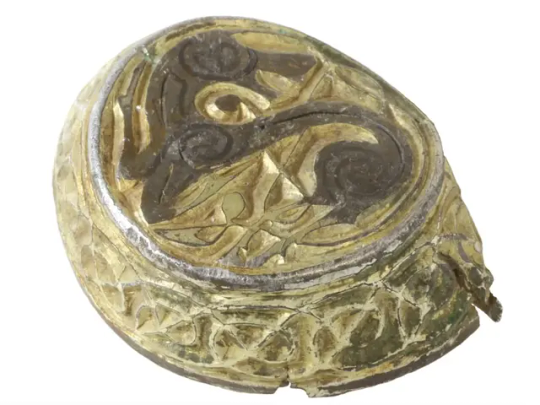
This 1,200-Year-Old Silver Artifact Is Stunning and Nobody Knows What It Is
The intricately decorated silver object was likely created by a highly skilled craftsperson in England
Metal detectorists have unearthed a tiny trinket covered in beautiful, intricate designs in Norfolk, England. The 1,200-year-old gilded silver artifact was likely created by skilled workers, but its purpose remains a mystery.
The strange object is about three-quarters of an inch in diameter. Found near the village of Langham, it resembles a small, crumpled cap. It’s adorned with tactile patterns and the image of an animal resembling a horse.
The artifact captivated historian Helen Geake, Norfolk’s finds liaison officer, reports BBC News’ Katy Prickett.
“It’s so tiny, and yet it was created just as carefully as something like a Bible or piece of jewelry,” says Geake, who has also appeared as an expert on the archaeology television show “Time Team.”
Based on the object’s complicated design, Geake infers that its craftsperson was “multi-talented and doing lots of different things.” The creator likely mixed imported Spanish mercury with powdered gold to create a gilding liquid, not unlike the paints used in illuminated manuscripts—handwritten books adorned with metallics and colorful drawings—made around the same time.
Geake recognizes the spiral pattern on the object’s sides from two illuminated manuscripts, both containing the four gospels of the New Testament: the 1,200-year-old Book of Kells and the 1,300-year-old Lindisfarne Gospel.
The newly discovered artifact dates to the late eighth or early ninth century. Its dominant motif, the animal carved and delicately painted on its top, could be a horse with its head turned backward, says Geake. Outlined by gold, the horse is dark brown, with dark swirling lines drawn through its body. Its face is shown in profile, with one eye visible.
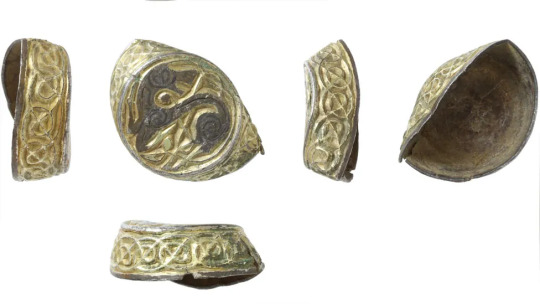
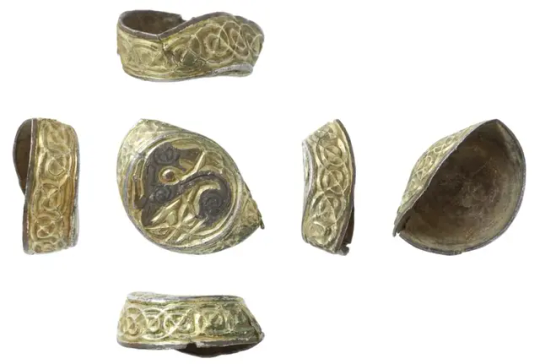
“I love its color,” she tells BBC News. “A lot of the time, we don’t see the colors of the past because clothes don’t survive and enamels drop out of settings.”
The expensive materials and highly detailed artisanship suggest the object was treasured, perhaps serving a meaningful personal or religious purpose, writes the Telegraph’s Craig Simpson. One possibility, Geake suggests, is that it was once a decorative cap on the end of a staff.
Archaeological discoveries are “consistently churned up from the Norfolk soil,” according to the Telegraph. In 2022, the county reported the most treasure finds of any area in the United Kingdom.
Though many curious objects have been discovered in Norfolk, Geake says the gilded cap is “completely unlike” any other find. BBC News reports that it has been declared a treasure, and the local Norwich Castle Museum expressed interest in acquiring it, despite its unknown purpose.
“It’s a mysterious object, and you can’t say what kind of thing it’s off at all,” Geake adds. “But it was made by someone with a real eye for loveliness.”
By Sonja Anderson.


#This 1200-Year-Old Silver Artifact Is Stunning and Nobody Knows What It Is#silver#silver jewelry#silver artifact#ancient artifacts#metal detecting#archeology#archeolgst#history news#ancient history#ancient culture#ancient civilizations#ancient art
24 notes
·
View notes
Text
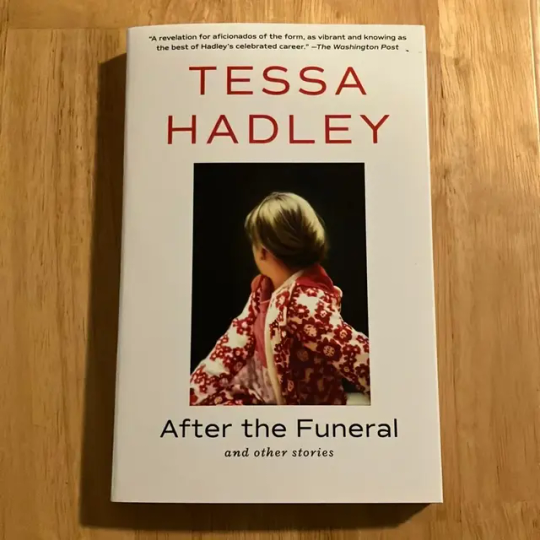
After the Funeral by Tessa Hadley
Class and character are sharply observed in this immersive collection
Tessa Hadley presents everything as fine at the front while it comes apart comprehensively at the back. The dozen short stories that comprise After the Funeral, her absorbing and thoroughly readable fourth collection, manage with a quiet dexterity the emotional situations that promote this kind of undoing.
Lynette, central character of Dido’s Lament, bumps into – or is bumped into by – Toby, her ex of many years. The collision, and what they make of it, will maintain a certain ambivalence. Who actually bumped into whom? Which of them, if either, has recovered from the damage they did one another in the past? Elsewhere it’s a different story, although as a story Old Friends occupies the same carefully curated kind of space: Christopher and Sally are made for one another – “she fitted into the shape of his own serious nature like a nut in its nutshell”. But Sally is still married to celebrity BBC war correspondent Frank, so she decides they’ll have to wait. Christopher isn’t sure what they are waiting for exactly, while the “whole exaggerated scale of Frank’s personal operation” continues to draw in everyone else “like a baggage train dragged after some showy emperor”.
That use of “personal operation” to describe a familiar kind of energetically middle-aged male narcissism sums up Hadley’s talent: the ruthless analysis of unstable situations, and of how we maintain them while we extract their resources. Her unpicking of character is focused, intense and yet always, somehow, in parallel, kind. What it does best is produce in the reader exactly what she offers her characters, for a sickening moment or two, in each story: a vast, difficult, unruly elation. For this to work, they need to arrive in front of us with comprehensive histories.
They’re often mature survivors of the 1970s or the children of those survivors: lecturers, musicians, civil servants, writers, comfortably off, less comfortably self-aware. Angie, for instance, has “escaped” a “posh county family” while Sally does “something or other part-time for the British Council”. Your overall impression – perhaps unfair – is that they have settled somewhere between Bristol and the Cotswolds in shabbily expensive old houses. The author lays off them a little but details their floor coverings and kitchen tables in gleeful closeup. They’re at ease enough with their class to enjoy the way someone holds a fork (“the poised, elegant angle of her wrist and her rather big tanned hand”). They support an affective regime in which everything from sex to nice cooking is a performance, a controllable resource that can be withdrawn instantly, “like a favour they were bored with proffering”. It’s not that the stories can’t be told without these densely worked characteristics of theirs, more that the character is the story. Often, perhaps, too obviously. Children at Chess, a study not much more than three pages long, remains unstorified by the strange little point-of-view flip in its last paragraph – although similar brisk redirections of readerly gaze are used successfully elsewhere to finesse endings that combine delicacy and horsepower.
A Hadley story will often require an outsider, or at least someone who thinks of themselves as an outsider – someone who performs that role not so much for us, the readers, but to and for the other characters. Difference is to be cherished, from the ad hoc hippy rituals of My Mother’s Wedding through the faddy diet and spectacular dissociation of Robyn, titular child of Funny Little Snake, to the cast of The Bunty Club, in which three middle-aged sisters still unconsciously await the “all transforming mystery” hinted at by their ramshackle childhood in a house by the sea. Adults who don’t fully remember an odd upbringing are still trying to find somewhere to fit in while their hearts seem to understand that childhood long ago shaped their adult circumstances. You could find this conclusion banal, but the author’s deft switches from comedy to drama won’t permit it. Sometimes a kind of gothic is required to turn the trick: there are pungent, luxurious descriptions of magic gardens, magic houses, magic families, and especially of magic interiors in which something’s not quite right – though never visibly wrong. Rain “comes sluicing” across big windows, wheelie bins blow over, rooms are either “greenish and spectral or bleak with the lights on in the middle of the day”. The disaster is sensed, if never quite consummated.
And anyway, down the road somewhere another story is always already fermenting. In Men, two women called Jan and Michelle find themselves in a hotel bar. They are sisters, but in the Hadley way: that is, they haven’t set eyes on one another for 15 years. We want to know why. Beautiful Jan is “tall and serene, and pale”. Michelle works in the hotel office, never was beautiful, has “a little pasty face as soft as putty”. She’s instantly aware of her sister’s presence, “like an animal picking up a scent, a smear of something rank”. The men, meanwhile, unaware of this suddenly resumed, weirdly tense relationship, are loud and middle-aged; stand easily at the bar, relaxing into their money.
What’s revealed before the story ends might change something, even for them, smug as they are. More likely, it will make a small but significant adjustment in the reader’s view of the world. In a 2007 review of Hadley’s first collection, Anne Enright described her as “immensely subversive” – a judgment that has only gathered force since. Whatever Hadley’s characters believe about themselves, they’re always working hard for change, striving, consciously or otherwise, to knock the props out from under whatever life they’re leading.
Daily inspiration. Discover more photos at Just for Books…?
6 notes
·
View notes
Text


This is the fourth in our occasional series featuring luminaries of stage and screen with a strong personal and/or professional connection with Northeast England, inspired with thanks by @robbielewis. Previous profiles were of Jean Heywood, John Nightingale and Edward Wilson. This time, Sunderland born actor siblings Malcolm and Catherine Terris.
Malcolm Terris was born on January 11th, 1941, boarded at Barnard Castle School in County Durham, then worked as a cadet journalist at the Sunderland Echo before training as an actor.
He was active on British television from 1963, his style perfectly suited to larger than life characters, and is possibly best remembered for his role as Great War veteran and salt-of the-earth union leader, Matt Headley, in 34 episodes of the Tyneside interwar social-realism drama, When the Boat Comes In.
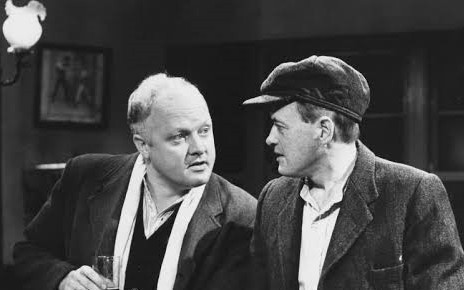
As Matt Headley, with James Bolam (Jack Ford) in When the Boat Comes In.
His more than 120 recorded screen credits include a variety of British television programmes, including Fall of Eagles, Doctor Who (Horns of Nimon, 1979), Reilly: Ace of Spies, three separate roles in Coronation Street, Our Friends in the North, The Bill, and a regular role in Rockliffe’s Babies. His final appearance was in Midsomer Murders in 2011.
His big screen appearances include as ship’s surgeon, with Anthony Hopkins as Bligh and Mel Gibson as Fletcher Christian, in The Bounty (1984), with Ricky Tomlinson in Mike Bassett: England Manager, and in Dickie Attenborough’s Chaplin, which starred Robert Downey Jnr in the title role. He has also appeared on stage including in productions of Othello and in a Broadway production of Hamlet.
He passed away at the artistes residential care home, Denville Hall, on June 6th, 2020, aged 79.
Catherine Terris was born in 1948, and trained at the London Academy of Music and Dramatic Art (LAMDA). She has been active in British television since 1972, appearing with her brother in seven episodes of When the Boat Comes In. Her other television work includes Z Cars, two roles in Coronation Street, Anna Karenina, Inspector Morse, Dalziel and Pascoe, Heartbeat, George Gently, and a regular role (15 episodes) in William and Mary with Martin Clunes and Julie Graham. She also appeared in the hugely successful feature film, The Best Exotic Marigold Hotel.
According to her page on the Coronation Street fan site, Corriepedia:
"...On stage she has appeared in productions of Faustus, A Rite Kwik Metal Tata, Andy Capp, Tight at the Back, Rose, Tom Jones, Billy Liar, Queuing for Everest and Into the Blue..."
Her most recent television screen credit is In the Club (BBC 2014-16) and latest big screen appearance was in the 2021 feature film, Martyrs Lane.

On stage with Sarah Gordy MBE (The A Word, Ralph and Katie) in the 2016 Arcola Theatre production of Into the Blue, written by Beverley Hancock and directed by Deborah Paige. Image from Sarah Gordy's official site.
#social history#working class history#tyne and wear#sunderland#british actors#british cinema#british television#british theatre#british culture#northeast england
20 notes
·
View notes
Text
"Well, saints be praised, someone is finally listening to us. The BBC has just announced that it is to make a brand new adaptation of the Famous Five books, made up of three 90-minute episodes. Oh, and they’re going to be written and directed by Nicolas Winding Refn.
Which might not seem like an immediately natural fit, obviously. The Famous Five books revel in the sort of safe home counties nostalgia, full of smashing feats and spiffing feasts, that have not in any way reflected any form of British life for at least half a century. Nicolas Winding Refn, meanwhile, once made The Neon Demon; a film in which one young woman brings herself to orgasm while straddling a corpse, and another vomits up a human eyeball. What I’m trying to say is that the connection isn’t immediate.
But that should be OK, because creatives should be allowed to follow their muse wherever they see fit. Martin Scorsese might be best known for his violent mob dramas, for instance, but don’t forget that he also once made Hugo; a 3D children’s movie about a lovely train station. Was it his best work? No. But did it also feel at times like his most personal? Yes. The same goes for Francis Ford Coppola and Jack, David Lowery and Peter Pan & Wendy or George Miller and Happy Feet. A great director can turn their hand to any type of material, for any audience. And if that means Nicolas Winding Refn making a miniseries about wholesome child detectives, then so be it."
NWR messing with stuff is always fun.
5 notes
·
View notes
Text
FRAUDULENT
By Daniel Jupp: a great summary of why 2020 was a fraudulent election, no matter how people try to deny it.
"Amazing to see alleged Republicans still claiming that Biden got 81 million real votes. I suppose this acceptance will increase among the gullible following the Dominion settlement. So it’s time for a reminder.
There were a historic number of red flag fraud indicators for 2020, whilst at the same time the alleged result breaks just about every results indicator used by pollsters.
Commonly accepted red flag indicators of fraud are: 1. Statistically highly unlikely results 2. Statistically highly unlikely turnouts 3. Changes to procedures in the run up to the election 4. Sudden counting suspensions or delays 5. Statistically contradictory results 6. Extended or lengthy voting 7. Eyewitness accounts of fraudulent behaviour. 8. Violence or force to prevent voting or disguise fraud.
2020 had every single one of these. It matched a BBC report checklist on red flag indicators on disputed elections in African dictatorships. That’s how bad it was.
But there’s also very reliable indicators of how an election will go. These indicators have a track record of successfully predicting results going back a century, yet they are shattered by the 2020 result (not one indicator, but EVERY indicator). Prediction by primary performance-shattered. Prediction by share of belweather counties-shattered. Prediction by the winner of three key states-shattered. Prediction by support polling-shattered. All of these normally line up with who has legitimately won.
The only other modern election with these patterns being broken was 1960, now widely acknowledged by many historians as having been determined by fraud (interestingly since 2020 sites like Wikipedia have adjusted descriptions of 1960 to minimise fraud claims. I wonder why?). 1960 only broke some of the indicators, 2020 breaks EVERY established pattern for determining the winner.
Any rational person knows that if an incumbent President adds 12 million votes he wins and that an unpopular candidate does not add 15 million votes over a previous popular candidate of the same party. Obama won his second term having LOST millions of votes. This is fairly normal for second term victories. What has NEVER happened before is a record breaking increase in vote leading to a defeat for the incumbent.
No single honest election sees the greatest ever performance by an incumbent topped by the greatest ever performance by a challenger. Logically, a great performance comes at the cost of a poor performance from the other candidate. Not both being massively record breaking. The numbers for 2020 are both astronomical and ludicrous. Millions of new voters popped into existence overnight, ‘coincidentally’ with the innovations of extensive mail in ballots and lengthy extended voting and lengthy extended vote counting. Biden ‘won’ with the lowest ever share of counties, Trump ‘lost’ with the greatest ever increase of votes. That combination alone is so statistically unlikely as to be in the same order of plausibility as a man successfully balancing an elephant on his nose.
To give another analogy. A thrashing in a sporting contest is unlikely. Two competitors BOTH breaking every existing record there is in the same match is virtually impossible. Imagine a tennis match where both players get more aces than ever seen in a match before, and one has a 100% success rate with their serves but is beaten by a guy who somehow has a 124% success rate with their serves, a statistical impossibility. Trump thrashed all prior records, and Biden thrashed that?
That can only be achieved by fraud.
Anyone who doesn’t have the wit to notice this stuff, the logic to recognise it, or the integrity to admit it, is worthless."FRAUD
7 notes
·
View notes